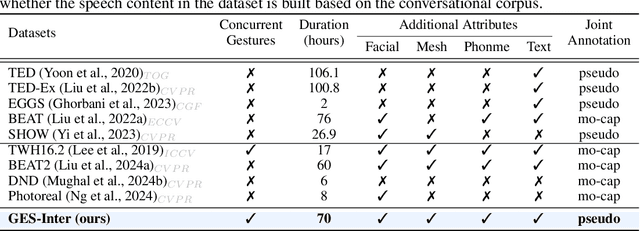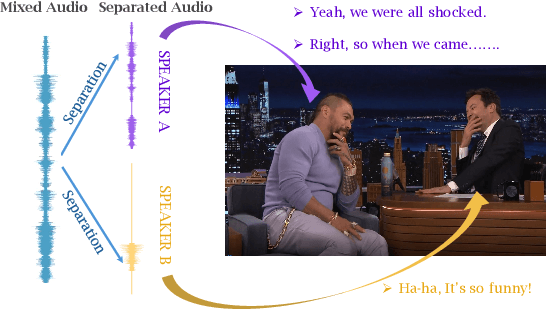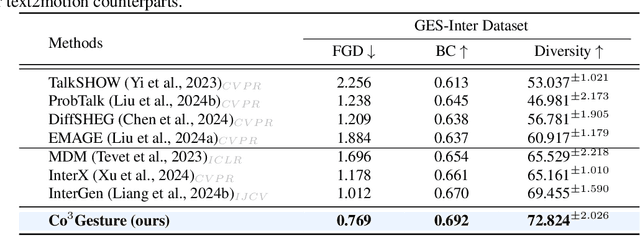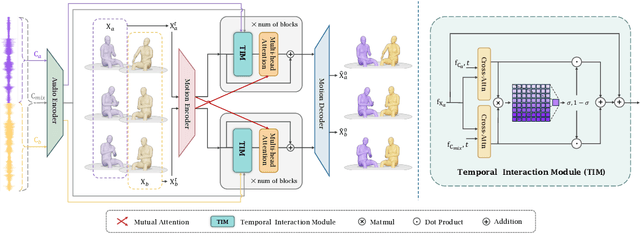Xingqun Qi
DanceEditor: Towards Iterative Editable Music-driven Dance Generation with Open-Vocabulary Descriptions
Aug 24, 2025Abstract:Generating coherent and diverse human dances from music signals has gained tremendous progress in animating virtual avatars. While existing methods support direct dance synthesis, they fail to recognize that enabling users to edit dance movements is far more practical in real-world choreography scenarios. Moreover, the lack of high-quality dance datasets incorporating iterative editing also limits addressing this challenge. To achieve this goal, we first construct DanceRemix, a large-scale multi-turn editable dance dataset comprising the prompt featuring over 25.3M dance frames and 84.5K pairs. In addition, we propose a novel framework for iterative and editable dance generation coherently aligned with given music signals, namely DanceEditor. Considering the dance motion should be both musical rhythmic and enable iterative editing by user descriptions, our framework is built upon a prediction-then-editing paradigm unifying multi-modal conditions. At the initial prediction stage, our framework improves the authority of generated results by directly modeling dance movements from tailored, aligned music. Moreover, at the subsequent iterative editing stages, we incorporate text descriptions as conditioning information to draw the editable results through a specifically designed Cross-modality Editing Module (CEM). Specifically, CEM adaptively integrates the initial prediction with music and text prompts as temporal motion cues to guide the synthesized sequences. Thereby, the results display music harmonics while preserving fine-grained semantic alignment with text descriptions. Extensive experiments demonstrate that our method outperforms the state-of-the-art models on our newly collected DanceRemix dataset. Code is available at https://lzvsdy.github.io/DanceEditor/.
ReMeREC: Relation-aware and Multi-entity Referring Expression Comprehension
Jul 22, 2025Abstract:Referring Expression Comprehension (REC) aims to localize specified entities or regions in an image based on natural language descriptions. While existing methods handle single-entity localization, they often ignore complex inter-entity relationships in multi-entity scenes, limiting their accuracy and reliability. Additionally, the lack of high-quality datasets with fine-grained, paired image-text-relation annotations hinders further progress. To address this challenge, we first construct a relation-aware, multi-entity REC dataset called ReMeX, which includes detailed relationship and textual annotations. We then propose ReMeREC, a novel framework that jointly leverages visual and textual cues to localize multiple entities while modeling their inter-relations. To address the semantic ambiguity caused by implicit entity boundaries in language, we introduce the Text-adaptive Multi-entity Perceptron (TMP), which dynamically infers both the quantity and span of entities from fine-grained textual cues, producing distinctive representations. Additionally, our Entity Inter-relationship Reasoner (EIR) enhances relational reasoning and global scene understanding. To further improve language comprehension for fine-grained prompts, we also construct a small-scale auxiliary dataset, EntityText, generated using large language models. Experiments on four benchmark datasets show that ReMeREC achieves state-of-the-art performance in multi-entity grounding and relation prediction, outperforming existing approaches by a large margin.
Co$^{3}$Gesture: Towards Coherent Concurrent Co-speech 3D Gesture Generation with Interactive Diffusion
May 03, 2025



Abstract:Generating gestures from human speech has gained tremendous progress in animating virtual avatars. While the existing methods enable synthesizing gestures cooperated by individual self-talking, they overlook the practicality of concurrent gesture modeling with two-person interactive conversations. Moreover, the lack of high-quality datasets with concurrent co-speech gestures also limits handling this issue. To fulfill this goal, we first construct a large-scale concurrent co-speech gesture dataset that contains more than 7M frames for diverse two-person interactive posture sequences, dubbed GES-Inter. Additionally, we propose Co$^3$Gesture, a novel framework that enables coherent concurrent co-speech gesture synthesis including two-person interactive movements. Considering the asymmetric body dynamics of two speakers, our framework is built upon two cooperative generation branches conditioned on separated speaker audio. Specifically, to enhance the coordination of human postures with respect to corresponding speaker audios while interacting with the conversational partner, we present a Temporal Interaction Module (TIM). TIM can effectively model the temporal association representation between two speakers' gesture sequences as interaction guidance and fuse it into the concurrent gesture generation. Then, we devise a mutual attention mechanism to further holistically boost learning dependencies of interacted concurrent motions, thereby enabling us to generate vivid and coherent gestures. Extensive experiments demonstrate that our method outperforms the state-of-the-art models on our newly collected GES-Inter dataset. The dataset and source code are publicly available at \href{https://mattie-e.github.io/Co3/}{\textit{https://mattie-e.github.io/Co3/}}.
VividListener: Expressive and Controllable Listener Dynamics Modeling for Multi-Modal Responsive Interaction
Apr 30, 2025



Abstract:Generating responsive listener head dynamics with nuanced emotions and expressive reactions is crucial for practical dialogue modeling in various virtual avatar animations. Previous studies mainly focus on the direct short-term production of listener behavior. They overlook the fine-grained control over motion variations and emotional intensity, especially in long-sequence modeling. Moreover, the lack of long-term and large-scale paired speaker-listener corpora including head dynamics and fine-grained multi-modality annotations (e.g., text-based expression descriptions, emotional intensity) also limits the application of dialogue modeling.Therefore, we first newly collect a large-scale multi-turn dataset of 3D dyadic conversation containing more than 1.4M valid frames for multi-modal responsive interaction, dubbed ListenerX. Additionally, we propose VividListener, a novel framework enabling fine-grained, expressive and controllable listener dynamics modeling. This framework leverages multi-modal conditions as guiding principles for fostering coherent interactions between speakers and listeners.Specifically, we design the Responsive Interaction Module (RIM) to adaptively represent the multi-modal interactive embeddings. RIM ensures the listener dynamics achieve fine-grained semantic coordination with textual descriptions and adjustments, while preserving expressive reaction with speaker behavior. Meanwhile, we design the Emotional Intensity Tags (EIT) for emotion intensity editing with multi-modal information integration, applying to both text descriptions and listener motion amplitude.Extensive experiments conducted on our newly collected ListenerX dataset demonstrate that VividListener achieves state-of-the-art performance, realizing expressive and controllable listener dynamics.
EVA: An Embodied World Model for Future Video Anticipation
Oct 20, 2024



Abstract:World models integrate raw data from various modalities, such as images and language to simulate comprehensive interactions in the world, thereby displaying crucial roles in fields like mixed reality and robotics. Yet, applying the world model for accurate video prediction is quite challenging due to the complex and dynamic intentions of the various scenes in practice. In this paper, inspired by the human rethinking process, we decompose the complex video prediction into four meta-tasks that enable the world model to handle this issue in a more fine-grained manner. Alongside these tasks, we introduce a new benchmark named Embodied Video Anticipation Benchmark (EVA-Bench) to provide a well-rounded evaluation. EVA-Bench focused on evaluating the video prediction ability of human and robot actions, presenting significant challenges for both the language model and the generation model. Targeting embodied video prediction, we propose the Embodied Video Anticipator (EVA), a unified framework aiming at video understanding and generation. EVA integrates a video generation model with a visual language model, effectively combining reasoning capabilities with high-quality generation. Moreover, to enhance the generalization of our framework, we tailor-designed a multi-stage pretraining paradigm that adaptatively ensembles LoRA to produce high-fidelity results. Extensive experiments on EVA-Bench highlight the potential of EVA to significantly improve performance in embodied scenes, paving the way for large-scale pre-trained models in real-world prediction tasks.
PSHuman: Photorealistic Single-view Human Reconstruction using Cross-Scale Diffusion
Sep 16, 2024



Abstract:Detailed and photorealistic 3D human modeling is essential for various applications and has seen tremendous progress. However, full-body reconstruction from a monocular RGB image remains challenging due to the ill-posed nature of the problem and sophisticated clothing topology with self-occlusions. In this paper, we propose PSHuman, a novel framework that explicitly reconstructs human meshes utilizing priors from the multiview diffusion model. It is found that directly applying multiview diffusion on single-view human images leads to severe geometric distortions, especially on generated faces. To address it, we propose a cross-scale diffusion that models the joint probability distribution of global full-body shape and local facial characteristics, enabling detailed and identity-preserved novel-view generation without any geometric distortion. Moreover, to enhance cross-view body shape consistency of varied human poses, we condition the generative model on parametric models like SMPL-X, which provide body priors and prevent unnatural views inconsistent with human anatomy. Leveraging the generated multi-view normal and color images, we present SMPLX-initialized explicit human carving to recover realistic textured human meshes efficiently. Extensive experimental results and quantitative evaluations on CAPE and THuman2.1 datasets demonstrate PSHumans superiority in geometry details, texture fidelity, and generalization capability.
MMTrail: A Multimodal Trailer Video Dataset with Language and Music Descriptions
Jul 30, 2024



Abstract:Massive multi-modality datasets play a significant role in facilitating the success of large video-language models. However, current video-language datasets primarily provide text descriptions for visual frames, considering audio to be weakly related information. They usually overlook exploring the potential of inherent audio-visual correlation, leading to monotonous annotation within each modality instead of comprehensive and precise descriptions. Such ignorance results in the difficulty of multiple cross-modality studies. To fulfill this gap, we present MMTrail, a large-scale multi-modality video-language dataset incorporating more than 20M trailer clips with visual captions, and 2M high-quality clips with multimodal captions. Trailers preview full-length video works and integrate context, visual frames, and background music. In particular, the trailer has two main advantages: (1) the topics are diverse, and the content characters are of various types, e.g., film, news, and gaming. (2) the corresponding background music is custom-designed, making it more coherent with the visual context. Upon these insights, we propose a systemic captioning framework, achieving various modality annotations with more than 27.1k hours of trailer videos. Here, to ensure the caption retains music perspective while preserving the authority of visual context, we leverage the advanced LLM to merge all annotations adaptively. In this fashion, our MMtrail dataset potentially paves the path for fine-grained large multimodal-language model training. In experiments, we provide evaluation metrics and benchmark results on our dataset, demonstrating the high quality of our annotation and its effectiveness for model training.
M-LRM: Multi-view Large Reconstruction Model
Jun 11, 2024Abstract:Despite recent advancements in the Large Reconstruction Model (LRM) demonstrating impressive results, when extending its input from single image to multiple images, it exhibits inefficiencies, subpar geometric and texture quality, as well as slower convergence speed than expected. It is attributed to that, LRM formulates 3D reconstruction as a naive images-to-3D translation problem, ignoring the strong 3D coherence among the input images. In this paper, we propose a Multi-view Large Reconstruction Model (M-LRM) designed to efficiently reconstruct high-quality 3D shapes from multi-views in a 3D-aware manner. Specifically, we introduce a multi-view consistent cross-attention scheme to enable M-LRM to accurately query information from the input images. Moreover, we employ the 3D priors of the input multi-view images to initialize the tri-plane tokens. Compared to LRM, the proposed M-LRM can produce a tri-plane NeRF with $128 \times 128$ resolution and generate 3D shapes of high fidelity. Experimental studies demonstrate that our model achieves a significant performance gain and faster training convergence than LRM. Project page: https://murphylmf.github.io/M-LRM/
CoCoGesture: Toward Coherent Co-speech 3D Gesture Generation in the Wild
May 27, 2024



Abstract:Deriving co-speech 3D gestures has seen tremendous progress in virtual avatar animation. Yet, the existing methods often produce stiff and unreasonable gestures with unseen human speech inputs due to the limited 3D speech-gesture data. In this paper, we propose CoCoGesture, a novel framework enabling vivid and diverse gesture synthesis from unseen human speech prompts. Our key insight is built upon the custom-designed pretrain-fintune training paradigm. At the pretraining stage, we aim to formulate a large generalizable gesture diffusion model by learning the abundant postures manifold. Therefore, to alleviate the scarcity of 3D data, we first construct a large-scale co-speech 3D gesture dataset containing more than 40M meshed posture instances across 4.3K speakers, dubbed GES-X. Then, we scale up the large unconditional diffusion model to 1B parameters and pre-train it to be our gesture experts. At the finetune stage, we present the audio ControlNet that incorporates the human voice as condition prompts to guide the gesture generation. Here, we construct the audio ControlNet through a trainable copy of our pre-trained diffusion model. Moreover, we design a novel Mixture-of-Gesture-Experts (MoGE) block to adaptively fuse the audio embedding from the human speech and the gesture features from the pre-trained gesture experts with a routing mechanism. Such an effective manner ensures audio embedding is temporal coordinated with motion features while preserving the vivid and diverse gesture generation. Extensive experiments demonstrate that our proposed CoCoGesture outperforms the state-of-the-art methods on the zero-shot speech-to-gesture generation. The dataset will be publicly available at: https://mattie-e.github.io/GES-X/
Era3D: High-Resolution Multiview Diffusion using Efficient Row-wise Attention
May 19, 2024



Abstract:In this paper, we introduce Era3D, a novel multiview diffusion method that generates high-resolution multiview images from a single-view image. Despite significant advancements in multiview generation, existing methods still suffer from camera prior mismatch, inefficacy, and low resolution, resulting in poor-quality multiview images. Specifically, these methods assume that the input images should comply with a predefined camera type, e.g. a perspective camera with a fixed focal length, leading to distorted shapes when the assumption fails. Moreover, the full-image or dense multiview attention they employ leads to an exponential explosion of computational complexity as image resolution increases, resulting in prohibitively expensive training costs. To bridge the gap between assumption and reality, Era3D first proposes a diffusion-based camera prediction module to estimate the focal length and elevation of the input image, which allows our method to generate images without shape distortions. Furthermore, a simple but efficient attention layer, named row-wise attention, is used to enforce epipolar priors in the multiview diffusion, facilitating efficient cross-view information fusion. Consequently, compared with state-of-the-art methods, Era3D generates high-quality multiview images with up to a 512*512 resolution while reducing computation complexity by 12x times. Comprehensive experiments demonstrate that Era3D can reconstruct high-quality and detailed 3D meshes from diverse single-view input images, significantly outperforming baseline multiview diffusion methods.
 Add to Chrome
Add to Chrome Add to Firefox
Add to Firefox Add to Edge
Add to Edge